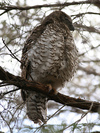Genus Ninox
Andaman Hawk Owl - Its natural habitats are subtropical or tropical moist lowland forests and subtropical or tropical mangrove forests. It is becoming rare due to habitat loss.
Togian Hawk-owl - The scientific name honours a local Indonesian conservationist called Burhan.
Barking Owl - The Barking Owl is coloured brown with white spots on its wings and a streaked chest. They have large eyes that have a yellow iris, a dark brown beak and almost no facial mask. Their underparts are brownish-grey and coarsely sotted white with their tail and flight feathers being moderately lighter in colour. They are a relatively medium sized owl and their wingspan is between 85–100 cm in length. They weigh between 425 and 510g and size varies only slightly between the male and female birds with the male Barking Owl being larger.
Cinnabar hawk-owl - Cinnabar Hawk Owl is small and has a relatively long tail and narrow pointed wings. The known four records of the species indicate it is a nocturnal forest dwelling species living at mid-altitudes . Otherwise very little is known of its habits. Based on morphological similarities with owlet-nightjars, Rasmussen suggests Cinnabar Hawk Owl may be an insectivore and prey on invertebrates in flight.
Solomon Islands Hawk-Owl - This species lives only on the Solomon Islands in lowlands and foothills at elevations up to 1500 meters above sea level. It is often found in primary or tall secondary forests.
Admiralty Islands Hawk Owl - This species is endemic to Manus Island, in the Admiralty Islands. It lives mainly in forests, but will appear in trees humans, and will sometimes occupy riparian habitats. It is fairly common throughout its limited range.
Christmas Island Hawk-Owl - The Christmas Island Hawk-Owl is a species of owl in the Strigidae family. It is endemic to Christmas Island. Its natural habitats are subtropical or tropical moist lowland forests and subtropical or tropical moist shrubland. It is threatened by habitat loss.
Southern Boobook - The subspecies Lord Howe Boobook and the Norfolk Island Boobook became both extinct during the 20th century. The name boobook is used by the Eora Australian Aboriginal tribe, who were the original inhabitants of the Sydney region.
Ochre-bellied Hawk-Owl - Its natural habitats are subtropical or tropical dry forests and subtropical or tropical moist lowland forests. It is threatened by habitat loss.
Russet Hawk-Owl - This species is found in the lowlands and hills of New Britain and New Ireland Endemic Bird Areas at elevations up to 1200 meters above sea level.
Philippine Hawk Owl - The Philippine Hawk Owl is an earless species. The males and females look much alike. The subspecies differ in size and pattern on the bottom side. N. p. reyi and N. p. spilonota are the biggest and N. p. philippensis, N. p. spilocephala and N. p. mindorensis the smallest. The pattern on the bottom side of N. p. reyi, N. p. spilonota and N. p. mindorensis is checked. The pattern on all the other subspecies is striped.
Speckled Hawk-Owl - This owl is found mainly in Indonesia and lives mainly in forests near streams, open woodland, and cultivated regions with scattered trees. It is mainly found below 1100 meters, but is occasionally seen at up to 2300 meters above sea level. It is fairly common throughout its range.
Sumba Boobook - Its natural habitats are subtropical or tropical dry forests and subtropical or tropical moist lowland forests. It is threatened by habitat loss.
Rufous Owl - Legge S., Heinsohn R., Blackman C. and Murphy S. Predation by Rufous owls on Eclectus parrots and other animals at Iron Range National Park, Cape York. Corella 27: 45-46
Brown Hawk-Owl - This species is a part of the larger grouping of owls known as typical owls, Strigidae, which contains most species of owl. The other grouping is the barn owls, Tytonidae.
Moluccan Hawk-Owl - Its natural habitat is subtropical or tropical moist lowland forests. It is threatened by habitat loss.
Powerful Owl - The Powerful Owl has large brown eyes, grey-brown V-barring on all features, large feathers and dull yellow feet. They are aptly named, with very powerful and heavy claws. Average length is 60 cm with a wingspan of 140 cm and weight of 1.5 kg .
Little sumba hawk-owl - Its natural habitat is subtropical or tropical moist lowland forests. It is threatened by habitat loss.
White-browed Hawk-Owl - Its natural habitats are subtropical or tropical moist lowland forests and subtropical or tropical moist montanes.
Jungle Hawk-Owl - It lives mainly in lowland forests, montane forests, and submontane forests, living mainly on the forests' edges. It is a resident of New Guinea and Papua New Guinea.
Bismarck Hawk-Owl - This species lives at elevations up to 1000 meters in lowland forests, tree-covered hills, low mountains,, and the edges of forests. It is found only in New Britain and New Ireland.

